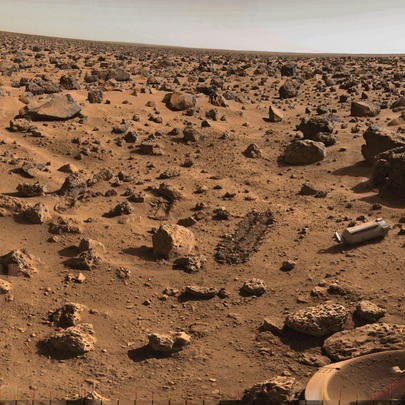We know that the surface of Mars has Ice, and scientist believe that at one point – about 3 billion years ago – the surface of Mars may have contained water, and was a lot wetter and warmer then it is today. But the researchers in charge of analysing the data on Martian soil that was collected during the 2008 NASA Phoenix mission, claim that the surface of Mars has been going through a super drought for over 600 million years. They said that despite the presence of ice, the planet is just to dry to sustain any type of life.
The researchers that tested the soil believe that Mars was exposed to water for about 5,000 years before drying out and freezing what ever little water the planet had left. Thanks to Satellite images and previous studies of the Martian soil, the scientist determined that water was present on the surface for far too short of a time for life to really get a foothold on the surface.
Dr Pike, from the Department of Electrical and Electronic Engineering at Imperial, who is lead author on the study published in the journal Geophysical Research Letters, explains:
“We found that even though there is an abundance of ice, Mars has been experiencing a super-drought that may well have lasted hundreds of millions of years. We think the Mars we know today contrasts sharply with its earlier history, which had warmer and wetter periods and which may have been more suited to life. Future NASA and ESA missions that are planned for Mars will have to dig deeper to search for evidence of life, which may still be taking refuge underground.”
In the study, the researchers were looking for microscopic clay particles formed when rock is broken down by water, however the team was unable to find such a marker. They found a particle similar to that, but they calculated that even if the few particles they saw in this size range were in fact clay, they made up less than 0.1 percent of the total proportion of the soil in the samples. On Earth, clays can make up to 50 percent or more of the soil content, so such a small proportion in the Martian samples suggests that the soil has had a very arid history.
The team found further evidence to support the idea that Martian soil has been largely dry throughout its history by comparing soil data from Mars, Earth and the Moon. The researchers deduced that the soil was being formed in a similar way on Mars and the Moon because they were able to match the distribution of soil particle sizes. On Mars, the team inferred that physical weathering by the wind as well as meteorites breaks down the soil into smaller particles. On the Moon, meteorite impacts break down rocks into soil, as there is no liquid water or atmosphere to wear down the particles.
So until we send out astronauts to Mars to start digging and looking for life living underground, the chances of life to ever had existed in Mars are slim to none. The possibility of underground lakes are still a very good, Lake Vostok is a liquid lake that’s resting underneath Antarctica, that lake is so deep that the core of the Earth is keeping it in liquid form, rather than iced over by the 2 miles of ice that rest above it. It is still possible for the ice chunk in Mars to have a lake underneath that’s being warmed by the core of the planet. [Science Daily]





